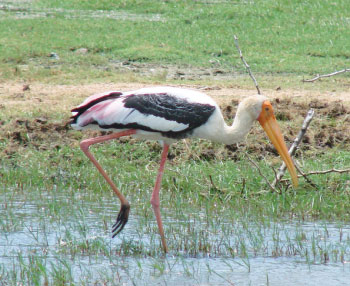|
 Today we bring you information about another national park in our
series of national parks. Today we bring you information about another national park in our
series of national parks.
Bundala National Park is a fantastic maze of waterways, lagoons and
dunes that glitter like gold in the dying evening sun. This wonderland
provides a home to thousands of colourful birds ranging from diminutive
little bee-eaters to grotesque open-billed stalks. It is a wetland
sanctuary of such importance that it has been recognised under the
Ramsar Convention on Wetlands.
It shelters some 150 species of birds within its 62-sq-km area, with
many journeying from Siberia and the Rann of Kutch in India to winter
here, arriving between August and April. It is also a winter home to the
greater flamingo, and up to 2000 have been recorded here at one time. If
you are a bird watcher, you'll want to devote a lot of time at this
park, if ever you have the opportunity to visit Bundala.
If you are interested in elephants, leopards and all the other big
mammals, then you will be pleased to hear that Bundala National Park
also has a small but very visible population of elephants (between 25
and 60 depending on the season), as well as civets, giant squirrels and
lots of crocodiles. Between October and January, four of Sri Lanka's
five species of marine turtles (olive ridley, green, leatherback and
loggerhead) lay their eggs on the coast.
Bundala stretches nearly 20 km along a coastal strip between Kirinda
and Hambantota. Access is easiest from Tissamaharama and Kirinda.
Bundala is open all the year-round. There's an excellent new visitors'
centre at the main gate.

Climate
The climate of Bundala National Park is hot and dry. While the
average temperature is 27 degrees Celsius, the annual rainfall varies
between 900mm to 1300 mm. Dry season' falls between May and September.
The best time to visit is September to March: during this period
migratory birds arrive at the park.
It is spread in an area that consists of mainly of dry thorny
scrublands, marshes and four brackish lagoons. The terrain is generally
flat with sand dunes bordering the coastline.
Birdlife at the Bundala National Park is a sight to behold. Each
species of water bird found in Sri Lanka is believed to visit Bundala
National Park . Nearly 200 species of birds have been recorded within
the park, out of which 58 species are migratory birds.
During September and March, hoards of migrants arrive in Bundala;
among them are Marsh and Curlew Sandpiper, Curlew and Greenshank Golden
and Kentish Plover, Large and Lesser Sandplovers. While the broad-billed
Sandpipper and red-necked Phalarope are the rare visitors, the most
famous migratory bird is greater flamingo. Hoards of flamingoes are one
of the most common sights. In this period over 10,000 shore birds might
be feeding at any one day.
The lagoons at the park attract a great variety of aquatic birds:
among them are ibis, pelicans, painted storks, Black-necked Stork,
terns, gulls, sand-pipers, snipes, teals, egrets and spoonbills. Endemic
birds include the Brown-capped Babbler, Ceylon Woodshrike and Ceylon
Junglefowl. Bundala is home to 32 species of mammals. Among them are
civets, wild boars, Grey and Ruddy mongoose, porcupine, giant Indian
palm squirrels, black-naped hares, Spotted Deer, Wild buffalo, the
endemic, jackal and fishing and Rusty Spotted cats. While most commonly
seen mammals are the hordes of grey langur and Toque Macaque.
Bundala National Park shelters a small population of elephants that
varies between 25 and 60 depending on the season.
It is also a habitat for several species of Reptiles. Bundala abounds
with estuarine crocodile and mugger crocodile. The coastal area attracts
Loggerhead Turtle, Green Turtle, Hawk's bill turtle and Olive Ridley:
four out of Sri Lanka's five marine turtle species, which come ashore to
lay their eggs Between October and January. Watching egg laying turtles
in the night, on the beaches of Bundala is a sight that no visitor would
forget in his lifetime.
Vegetation
|

A silhouette of the Bundala National Park, taken at the break of
dawn |
Among the 383 species of plants that have been recorded in Bundala,
six are endemic species. Seven are nationally threatened. The prominent
species are Weera (Drypetes Sepiaria), Palu( Manikara Hexandra), Satin (Chloroxylon
Sweitenia), Kohomba (Azadirachta Indica) and Divul (Limonia acidissima).
The dominant scrub is Andara.
- Internet |


